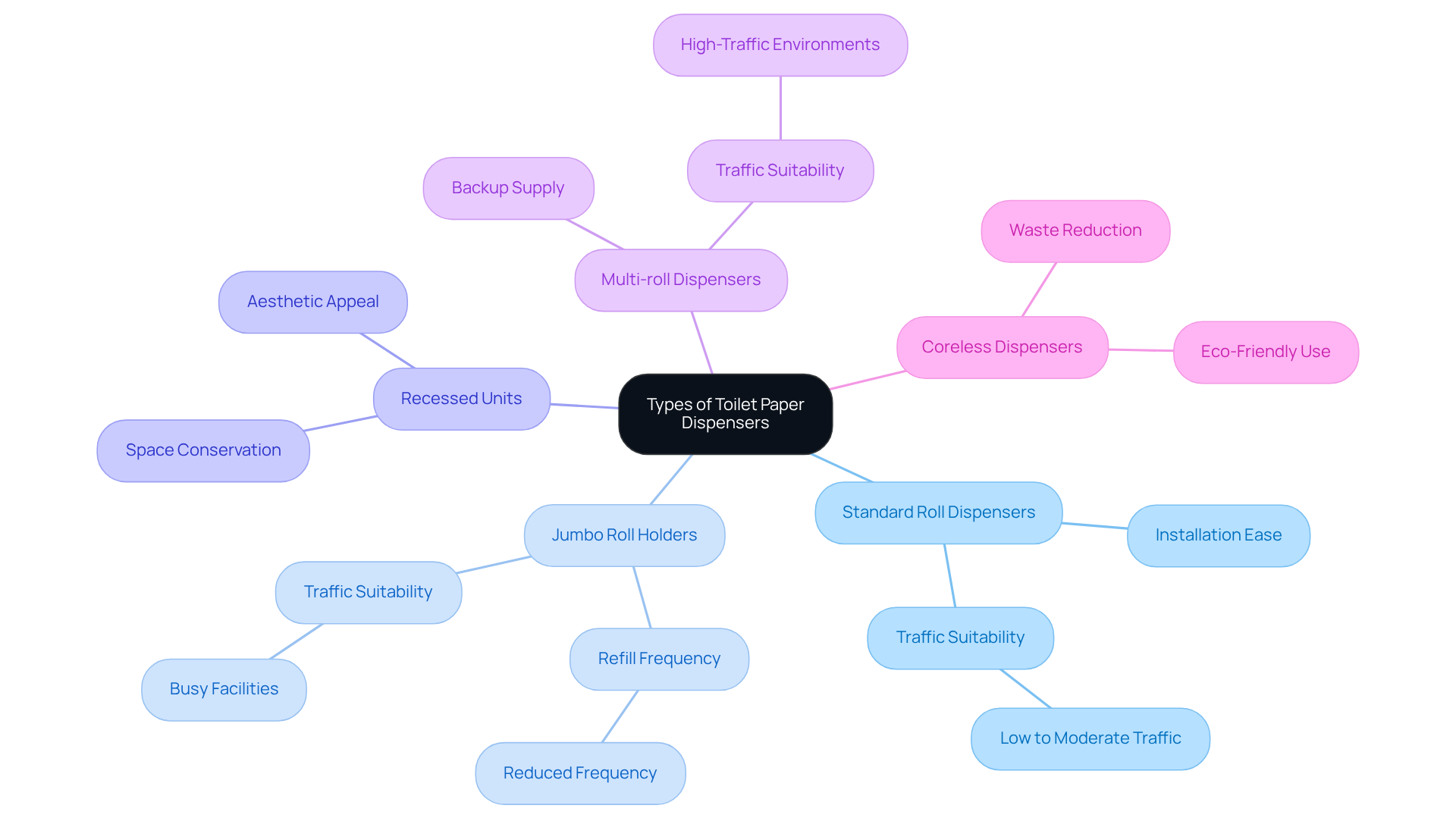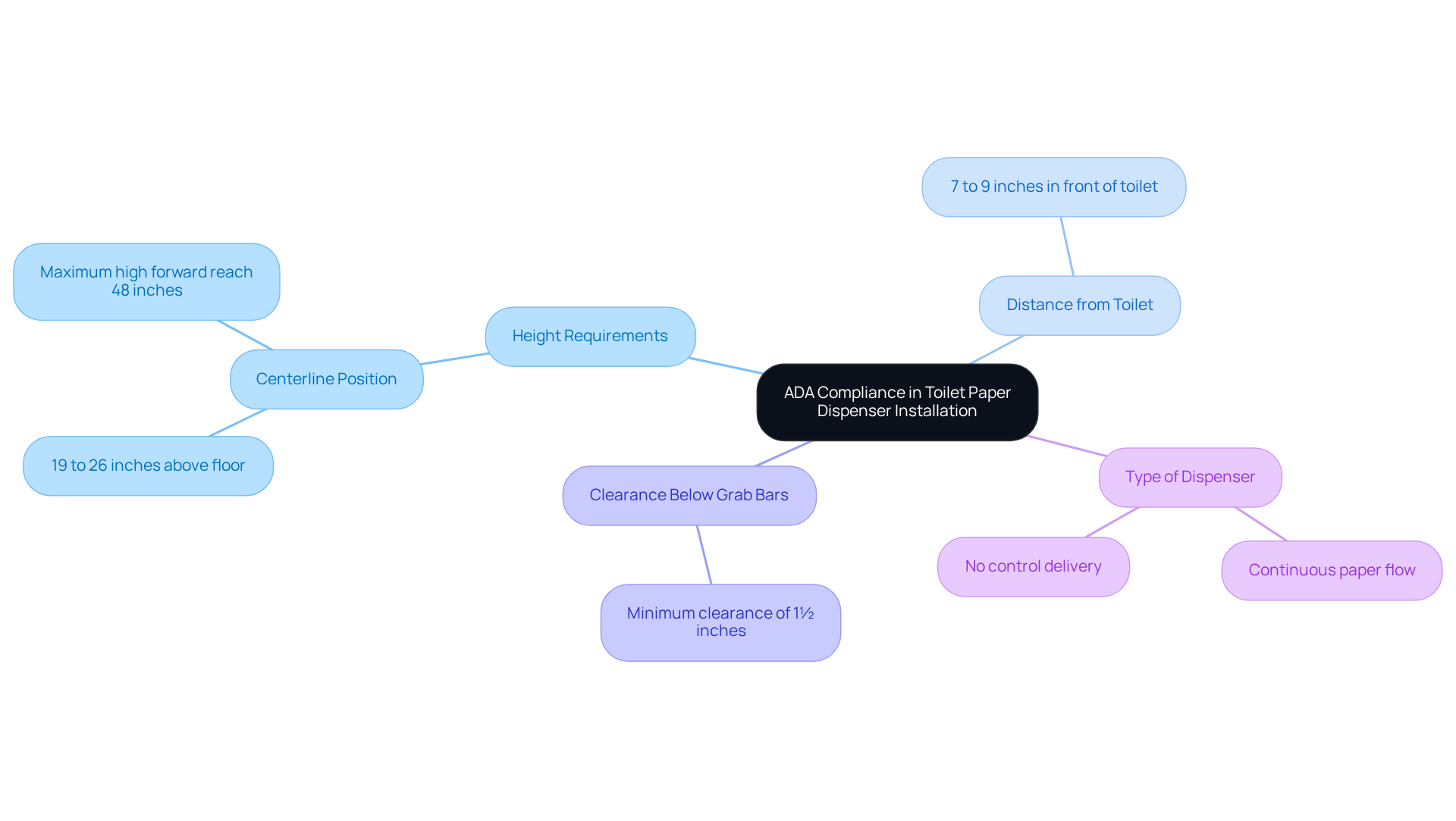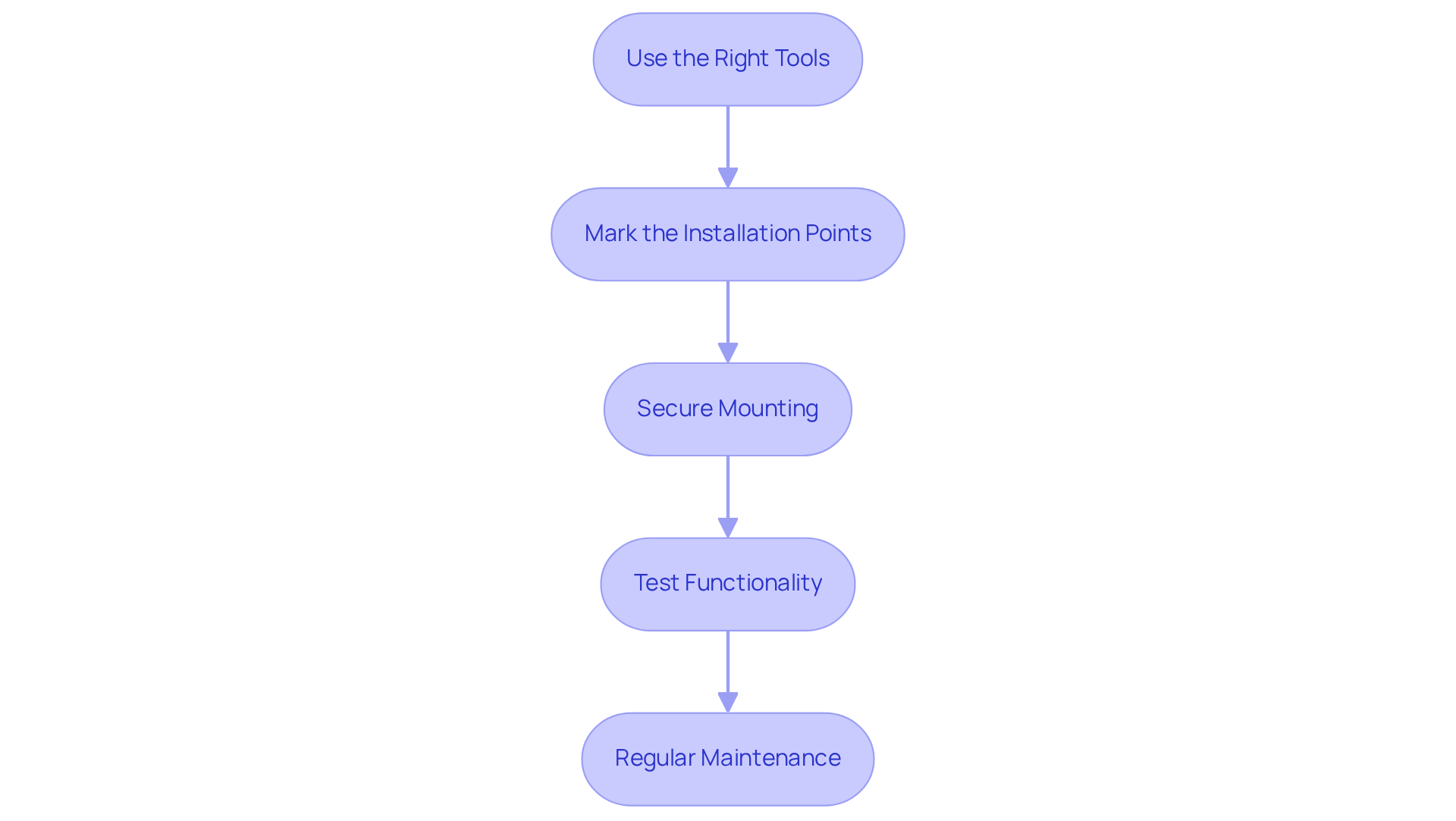Overview
This article provides a comprehensive overview of essential practices for the installation of toilet paper dispensers, underscoring the significance of selecting the appropriate type and ensuring compliance with the Americans with Disabilities Act (ADA). It details specific installation techniques and guidelines, including optimal height placement and secure mounting, which are vital for enhancing both functionality and accessibility in restroom environments. By adhering to these practices, facilities can ensure a user-friendly experience that meets the needs of all individuals.
Introduction
Selecting the right toilet paper dispenser transcends mere convenience; it is essential for enhancing the restroom experience for users and ensuring adherence to accessibility standards. This article explores best practices for installing commercial toilet paper dispensers, providing insights into various types, ADA compliance guidelines, and effective installation techniques. With a plethora of options and requirements to navigate, facility managers must determine how to select the most appropriate dispenser and install it correctly to circumvent common pitfalls.
Identify Suitable Types of Toilet Paper Dispensers for Your Facility
When selecting a toilet paper dispenser, it is essential to consider the various types available:
- Standard Roll Dispensers: These are the most common choice, suitable for low to moderate traffic areas. Their ease of installation and maintenance makes them a practical option.
- Jumbo Roll Holders: Ideal for busy facilities, these units accommodate larger rolls, significantly reducing the frequency of refills and ensuring that restroom supplies are consistently available for users.
- Recessed Units: Installed directly into the wall, these dispensers not only provide a stylish appearance but also conserve space, making them particularly well-suited for contemporary bathroom designs.
- Multi-roll Dispensers: Capable of holding multiple rolls, these units guarantee a backup supply, which is especially advantageous in high-traffic environments.
- Coreless Dispensers: Designed to minimize waste, these dispensers are often utilized in eco-friendly facilities, promoting a more efficient use of resources.
By carefully assessing the specific requirements of your facility—such as traffic levels and design preferences—you can select the most appropriate type of toilet paper dispenser commercial to improve the restroom experience.

Ensure ADA Compliance in Installation Practices
To ensure ADA compliance when installing toilet paper dispensers, it is essential to adhere to the following guidelines:
- Height Requirements: Position the centerline of the device between 19 inches and 26 inches above the finished floor. This range accommodates individuals in wheelchairs and those of varying heights, thereby enhancing accessibility. Notably, the maximum high forward reach for a wheelchair is 48 inches, underscoring the significance of this height range.
- Distance from the Toilet: Install the device 7 to 9 inches in front of the toilet to facilitate easy access without obstruction, ensuring that all individuals can reach it comfortably.
- Clearance Below Grab Bars: Maintain a minimum clearance of 1½ inches below any grab bars. This space is crucial for users to access the device unobstructed, particularly for those who rely on grab bars for assistance.
- Type of Dispenser: Choose dispensers that allow for continuous paper flow and do not control delivery. These designs are more accessible for individuals with disabilities, thereby enhancing the overall bathroom experience.
Furthermore, it is vital to incorporate accessible pathways into the overall facility layout to guarantee a smooth experience for everyone. Case studies, such as those from Padel Haus and Lacuna Space, illustrate successful ADA-compliant installations that enhance both functionality and aesthetics. By adhering to these ADA guidelines, you can create a restroom environment that is inclusive and accessible for all, reflecting a commitment to quality and functionality in restroom design.

Implement Effective Installation Techniques for Optimal Use
To achieve optimal use of toilet paper dispensers, it is essential to consider effective installation techniques.
- Use the Right Tools: Equip yourself with essential tools such as a drill, level, screwdriver, and wall anchors if necessary. Having the proper tools ensures a secure and precise installation.
- Mark the Installation Points: Prior to drilling, accurately mark the mounting points based on recommended heights—typically around 750mm for general bathrooms and 780-1000mm for accessible washrooms. The ADA guidelines indicate that the maximum height for a toilet paper holder should be 36 inches (91.4 cm) above the finished floor, ensuring accessibility for all users. This attention to detail guarantees correct positioning relative to the toilet.
- Secure Mounting: Utilize appropriate screws and anchors to firmly attach the device to the wall. It is crucial to avoid over-tightening, as this can result in damage to both the device and the wall.
- Test Functionality: After installation, thoroughly assess the device to confirm smooth operation and proper paper dispensing. This step is vital to identify any potential issues before the restroom is opened for public use. Frequent installation errors include incorrect height positioning and insufficient securing of the device, which can lead to functionality problems.
- Regular Maintenance: Implement a schedule for routine checks to ensure dispensers are adequately stocked and functioning correctly. This proactive maintenance can help prevent user frustration and maintain hygiene in the facilities.
As Brent Otsuka, Manager of Interior Design at Fentress Architects, observes, "Proper installation techniques are crucial for ensuring that bathroom fixtures meet both aesthetic and functional needs." By following these installation methods, you can ensure that the toilet paper dispenser commercial is not only functional but also enhances the overall bathroom experience. Successful installations, such as those completed for Padel Haus in New York and Lacuna Space in California, demonstrate the effectiveness of these practices in enhancing restroom environments.

Conclusion
Selecting the appropriate toilet paper dispenser transcends mere convenience; it is pivotal in enhancing user experience and ensuring compliance with accessibility standards. This article underscores the necessity of understanding the various types of dispensers available, adhering to ADA guidelines during installation, and implementing effective techniques to guarantee optimal functionality.
Key arguments discussed encompass the diverse types of dispensers—ranging from standard roll dispensers to eco-friendly coreless options—each tailored to specific facility needs. Furthermore, the significance of adhering to height and distance requirements for ADA compliance is emphasized, ensuring that all users can comfortably access restroom supplies. Effective installation techniques, including the use of appropriate tools and regular maintenance checks, are also crucial to avert common pitfalls that can undermine the user experience.
In conclusion, prioritizing the selection and installation of toilet paper dispensers can markedly enhance restroom accessibility and functionality. Facility managers are strongly encouraged to adopt these best practices, ensuring that their installations not only meet compliance standards but also cultivate a positive restroom experience for all users. By doing so, a commitment to quality and inclusivity in restroom design is established, reflecting the values of modern facilities.
Frequently Asked Questions
What are the different types of toilet paper dispensers available for facilities?
The main types of toilet paper dispensers include Standard Roll Dispensers, Jumbo Roll Holders, Recessed Units, Multi-roll Dispensers, and Coreless Dispensers.
What are Standard Roll Dispensers and where are they typically used?
Standard Roll Dispensers are the most common type and are suitable for low to moderate traffic areas. They are easy to install and maintain.
What advantages do Jumbo Roll Holders offer?
Jumbo Roll Holders are ideal for busy facilities as they accommodate larger rolls, reducing the frequency of refills and ensuring consistent availability of restroom supplies.
What are Recessed Units and what benefits do they provide?
Recessed Units are installed directly into the wall, offering a stylish appearance and conserving space, making them suitable for contemporary bathroom designs.
What is the purpose of Multi-roll Dispensers?
Multi-roll Dispensers can hold multiple rolls, providing a backup supply that is especially beneficial in high-traffic environments.
How do Coreless Dispensers contribute to sustainability?
Coreless Dispensers are designed to minimize waste, making them a popular choice in eco-friendly facilities by promoting more efficient resource use.
How should one choose the right type of toilet paper dispenser for their facility?
The right type of toilet paper dispenser should be selected by assessing specific requirements of the facility, such as traffic levels and design preferences.




